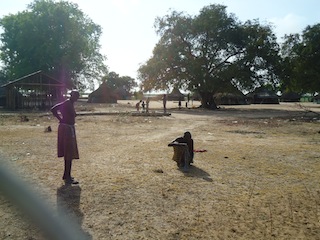Living with the curse of leprosy in South Sudan
February 11, 2013 (BOR/JUBA) – In a green valley beside the River Nile lies a village dotted with grass-thatched huts where an isolated 140 people call home. Children play outside and others pump water from the borehole, as elderly women loiter around the compound half naked.

Leprosy victims sought treatment from British Christian missionaries of the Church of England, established by Archdeacon Archibald Shaw. When Malek became the seat of Shaw’s church in 1905, Christian settlement commenced and leprosy patients found a home where they were accepted. That help, nearly 100 years ago, has since diminished.
“Look at this place, our neighbours are baboons and hippopotamus,” said Madhor Maker, a chief in charge of the leprosy sufferers.
Leprosy is a contiguous disease caused by the Bacterium mycobacterium that affects the skin, mucous membrane and the nerves, causing discoloration of the skin, deformities and disfigurement.
Leprosy victims here get no treatment during the early stages of the disease as is usually deemed necessary by medical petitioners to minimise transmission of the bacteria to other people. In turn, local villagers in Malek have little interaction with them.
“We were isolated since the first man came here about hundred years ago,” Maker added.
FEW VISITORS
According to local traditional beliefs, leprosy translates as a curse and few people visit the isolated village, 3km off the Bor-Juba road. Those that do go to the village are seen as kind-hearted people, with sufferers asking for a joint prayer before they leave.
“The leprosy victims say this is done to appease God to free the visitor from contacting the disease [leprosy] which they believe to be a curse,” said John Alier, a Sudan Tribune reporter who visited the victims.
Once known as pan abil (leprosy victims’ village), its name was later changed to paan koch lajik (village of holy people). The village is now home to about 148 leprosy sufferers living in about 30 huts.
Leprosy victims mainly from South Sudan’s Jonglei, Lakes and Central Equatoria states migrated to the village over the years and now all speak one dialect of the Dinka language, which is spoken by surrounding Dinka Bor population, who constitute the majority of victims here.
After the end of the second Sudanese civil war in 2005 assistance was provided to the village by both the Sudan Armed Forces (SAF) and the former rebel Sudan People’s Liberation Army (SPLA), who supplied food stuffs, medicines and clothing.
However, following 2005, there was a lapse in the flow of aid to leprosy victims but it resumed again in 2011 when the department of nutrition in Bor hospital started supplying them with food from the United Nations World Food Programme (WFP).
A medical source, speaking on condition of anonymity, told Sudan Tribune that plans are underway to secure better medical and food supplies to the leprosy victims.
IMPROVING LIVES
Over the past 30 years, Abraham Bol, a Christian pastor from Bor Diocese, has taken charge of victims’ issues and continues to campaign for their recognition as vulnerable people in Jonglei society.
Working without pay since 1990, Bol outlined a number of challenges facing the victims, including a lack of medical treatment for leprosy and other disease affecting them, food shortages and the lack of accessible roads leading to the village.
“Constant supply of food, mosquito nets, mats and blankets must be given priority. This is where their lives will improve”, said Bol.
With exception of children below 18 years of age, the adults have already experienced the worst ravages of the disease, with all toes and fingers completely removed.
“Look at our fingers and feet, all eaten up by leprosy, we cannot build houses for without ourselves, farm or do anything”, said a woman sitting nearby as she displayed her hands.
However, the victims’ village does have a water point and hand pump drilled with help of church caretakers.
Their relationship with neighbouring villages has also been improving in recent years as leprosy is now considered a more controllable disease.
“Today leprosy is known to be a disease like malaria and other diseases that are curable,” said an elderly man, who lives about two kilometres from the leprosy victims’ village, adding that in the past, it was regarded as a curse.
However, victims say that while relations have improved with surrounding communities, they still feel shunned by wider society.
“Today we pray with them together in the same church, their children are living with our children in the same classes, what has not happened is that [we] don’t always go there and they also rarely come here,” said one leprosy victim.
South Sudan continues to face numerous challenges in terms of service provision since it seceded from the north in July 2011. In Jonglei state, largely home to pastoral communities who are often locked in fierce fighting over cattle, the situation is complex and assistance to help improve the lives of leprosy sufferers is likely to remain scarce.
(ST)
